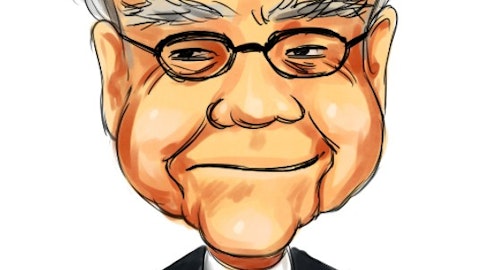Merck & Co., Inc. (NYSE:MRK) was down over 5% following disapproval of its latest cholesterol-related drug. The weakness is related to safety concerns surrounding a recent trial of its Tredaptive medicine, which increases HDL (good) cholesterol. Merck now plans to abandon seeking regulatory approval in the U.S. for the drug. We believe investors can now find value in a solid dividend payer amongst the selloff. Merck is one of the top ten pharma stocks loved by hedge funds (see all 10 here).
Merck had Tredaptive sales of about $13 million for the first three quarters of 2012 in the 40 countries where it is already sold. Estimates put global sales for the drug as high as $300 million by 2016 if it had been successfully approved for U.S. distribution. Merck also saw weakness earlier this year when its key drug Singulair – accounting for 11% of 2011 sales – went off patent protection. The recent Schering merger will help mitigate patent expiration weakness, especially since there is also little product overlap, which will help boost cross-selling and synergies related to sales, marketing and research.
We believe that Merck’s restructuring program – with the long-term annual savings goal of $4 billion – will eventually alleviate it of its less than stellar return on sales (14%) and low multiples. Part of the multiples pressure is related to merger restructuring and margin pressures. Cost reduction will also spur margin expansion, as Merck plans to reduce its workforce by 12% through 2015.
The other positive for the drug company is its robust pipeline. Despite the near-term pressures related to patent expirations, Merck has multiple drugs targeting various diseases and more than fifteen drug candidates in phase III development.
One of the key areas that might help Merck blow through analysts’ estimates is the drug company’s initiative to increase its presence in emerging markets. For 2011, 17% of sales were from emerging markets, with China being a key market driver. China remains one of the biggest potential growth machines for drug demand due to its rapidly increasing population and prosperity.
Merck has one of the largest pharmaceutical sales forces in China, having upped it by almost 100% over the last few years. One of the key initiatives for China’s growth is Merck’s plan to commercialize pediatric and adult vaccines in China. With these grandiose plans and positioning in key markets, we find the 3% expected 5-year earnings growth to be a bit unfair.
Continue reading to see how Merck stacks up against other major drug companies…
Pfizer Inc. (NYSE:PFE) was the top stock loved by hedge funds in 3Q and also pays a similar dividend yield to Merck at 3.8%. We continue to prefer Merck given its exposure to emerging markets and cheaper valuation when compared to Pfizer’s P/E (20x) and P/CF (11x). The long-term expected growth for the drug company is also lower than Merck at a 2% 5-year CAGR. Ken Fisher – founder of Fisher Asset Management – is one of Pfizer’s top shareholders (check out Ken Fisher’s newest picks).
AstraZeneca PLC (NYSE:AZN) is the smallest in terms of market value of the drug stocks listed and also trades out of line from the other companies. With a 6% dividend yield – and a 58% payout ratio – this drug company is an immediate attention-grabber. Couple this with its 10x P/E and 7x P/CF – the lowest valuation metrics of our stocks listed here – and we would be interested in taking a deeper look. Be wary though, of the stock’s 5-year expected earnings CAGR of -4%. Billionaire Steven Cohen of SAC Capital was also dumping some of this pharma stock last quarter (see Steven Cohen’s top picks).
GlaxoSmithKline PLC (NYSE:GSK) is another high-dividend paying pharma company with a yield of 5.3%. We do remain cautious that the stock does not boast as robust valuation metrics at 14x earnings and 14x cash flow, but its 6% long-term growth rate places it on the level of AstraZeneca in terms of attractiveness. Billionaire Warren Buffett is one of Glaxo’s big name investors with over 1.5 million shares (check out Warren Buffett’s new picks).
Johnson & Johnson (NYSE:JNJ) is similar to Merck in that we see growth potential thanks to its diverse drug/product portfolio and ability to tap the emerging markets. Johnson & Johnson pays a solid dividend yield at 3.5% and has one of the highest expected growth rates. Part of the reason we like Merck over Johnson & Johnson is that the latter has industry-high P/E and P/CF ratios, at 22x and 16x respectively. Billionaire George Soros was upping his stake over 1500% last quarter, though, so there is some support from the smart money (see all of George Soros’ big bets).
Merck is one of our top picks in the pharma industry as an underrated growth stock that pays a very solid dividend in a low-rate environment. The pharma company’s 19x trailing P/E is relatively in line with the industry, but its 12x forward P/E suggests investors are under-appreciating its growth prospects. If investors placed a 19x forward multiple on this year’s full year EPS estimates, the stock would trade upwards of $70, compared to its current share price in the $40 range. Continue reading about Merck in some of our recent coverage:
Merck Is One Of Billionaire Stanley Druckenmiller’s 5 Dividend Picks
Merck Is One Of 3 High-Yield Pharma Stocks With A Big Catalyst






